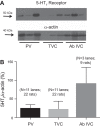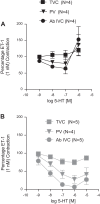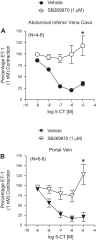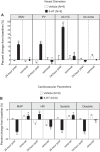5-HT causes splanchnic venodilation
- PMID: 28626072
- PMCID: PMC5625177
- DOI: 10.1152/ajpheart.00165.2017
5-HT causes splanchnic venodilation
Abstract
Serotonin [5-hydroxytryptamine (5-HT)] causes relaxation of the isolated superior mesenteric vein, a splanchnic blood vessel, through activation of the 5-HT7 receptor. As part of studies designed to identify the mechanism(s) through which chronic (≥24 h) infusion of 5-HT lowers blood pressure, we tested the hypothesis that 5-HT causes in vitro and in vivo splanchnic venodilation that is 5-HT7 receptor dependent. In tissue baths for measurement of isometric contraction, the portal vein and abdominal inferior vena cava relaxed to 5-HT and the 5-HT1/7 receptor agonist 5-carboxamidotryptamine; relaxation was abolished by the 5-HT7 receptor antagonist SB-269970. Western blot analyses showed that the abdominal inferior vena cava and portal vein express 5-HT7 receptor protein. In contrast, the thoracic vena cava, outside the splanchnic circulation, did not relax to serotonergic agonists and exhibited minimal expression of the 5-HT7 receptor. Male Sprague-Dawley rats with chronically implanted radiotelemetry transmitters underwent repeated ultrasound imaging of abdominal vessels. After baseline imaging, minipumps containing vehicle (saline) or 5-HT (25 μg·kg-1·min-1) were implanted. Twenty-four hours later, venous diameters were increased in rats with 5-HT-infusion (percent increase from baseline: superior mesenteric vein, 17.5 ± 1.9; portal vein, 17.7 ± 1.8; and abdominal inferior vena cava, 46.9 ± 8.0) while arterial pressure was decreased (~13 mmHg). Measures returned to baseline after infusion termination. In a separate group of animals, treatment with SB-269970 (3 mg/kg iv) prevented the splanchnic venodilation and fall in blood pressure during 24 h of 5-HT infusion. Thus, 5-HT causes 5-HT7 receptor-dependent splanchnic venous dilation associated with a fall in blood pressure.NEW & NOTEWORTHY This research is noteworthy because it combines and links, through the 5-HT7 receptor, an in vitro observation (venorelaxation) with in vivo events (venodilation and fall in blood pressure). This supports the idea that splanchnic venodilation plays a role in blood pressure regulation.
Keywords: SB-269970; blood pressure; imaging; pharmacology; serotonin; veins.
Copyright © 2017 the American Physiological Society.
Figures







Similar articles
-
5-HT7 Receptor Restrains 5-HT-induced 5-HT2A Mediated Contraction in the Isolated Abdominal Vena Cava.J Cardiovasc Pharmacol. 2021 Aug 1;78(2):319-327. doi: 10.1097/FJC.0000000000001057. J Cardiovasc Pharmacol. 2021. PMID: 34029269 Free PMC article.
-
5-HT does not lower blood pressure in the 5-HT7 knockout rat.Physiol Genomics. 2019 Jul 1;51(7):302-310. doi: 10.1152/physiolgenomics.00031.2019. Epub 2019 May 24. Physiol Genomics. 2019. PMID: 31125292 Free PMC article.
-
5-hydroxytryptamine (5-HT) reduces total peripheral resistance during chronic infusion: direct arterial mesenteric relaxation is not involved.BMC Pharmacol. 2012 May 6;12:4. doi: 10.1186/1471-2210-12-4. BMC Pharmacol. 2012. PMID: 22559843 Free PMC article.
-
Serotonin and blood pressure regulation.Pharmacol Rev. 2012 Apr;64(2):359-88. doi: 10.1124/pr.111.004697. Epub 2012 Mar 8. Pharmacol Rev. 2012. PMID: 22407614 Free PMC article. Review.
-
Oh, the places you'll go! My many colored serotonin (apologies to Dr. Seuss).Am J Physiol Heart Circ Physiol. 2016 Nov 1;311(5):H1225-H1233. doi: 10.1152/ajpheart.00538.2016. Epub 2016 Sep 23. Am J Physiol Heart Circ Physiol. 2016. PMID: 27663771 Free PMC article. Review.
Cited by
-
Statistical considerations in reporting cardiovascular research.Am J Physiol Heart Circ Physiol. 2018 Aug 1;315(2):H303-H313. doi: 10.1152/ajpheart.00309.2018. Epub 2018 Jul 20. Am J Physiol Heart Circ Physiol. 2018. PMID: 30028200 Free PMC article.
-
Guidelines for authors and reviewers on antibody use in physiology studies.Am J Physiol Heart Circ Physiol. 2018 Apr 1;314(4):H724-H732. doi: 10.1152/ajpheart.00512.2017. Epub 2018 Jan 5. Am J Physiol Heart Circ Physiol. 2018. PMID: 29351459 Free PMC article.
-
β-arrestin biased signaling is not involved in the hypotensive actions of 5-HT7 receptor stimulation: use of Serodolin.Pharmacol Res. 2024 Jan;199:107047. doi: 10.1016/j.phrs.2023.107047. Epub 2023 Dec 28. Pharmacol Res. 2024. PMID: 38157998 Free PMC article.
-
Creation of the 5-hydroxytryptamine receptor 7 knockout rat as a tool for cardiovascular research.Physiol Genomics. 2019 Jul 1;51(7):290-301. doi: 10.1152/physiolgenomics.00030.2019. Epub 2019 May 24. Physiol Genomics. 2019. PMID: 31125290 Free PMC article.
-
Can Serotonin 7 Receptors Be a Treatment Target for Noncentral Diseases?Eurasian J Med. 2023 Dec;55(1):S49-S54. doi: 10.5152/eurasianjmed.2023.23303. Eurasian J Med. 2023. PMID: 39128036 Free PMC article.
References
-
- Altura BM. Sex and estrogens and responsiveness of terminal arterioles to neurohypophyseal hormones and catecholamines. J Pharmacol Exp Ther 193: 403–412, 1975. - PubMed
-
- Bard JA, Zgombick J, Adham N, Vaysse P, Branchek TA, Weinshank RL. Cloning of a novel human serotonin receptor (5-HT7) positively linked to adenylate cyclase. J Biol Chem 268: 23422–23426, 1993. - PubMed
MeSH terms
Substances
Grants and funding
LinkOut - more resources
Full Text Sources
Other Literature Sources
Research Materials
Miscellaneous

